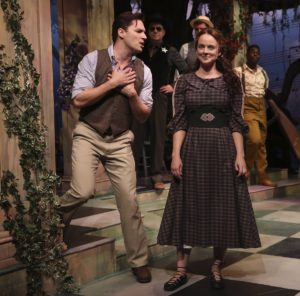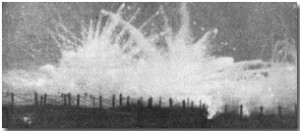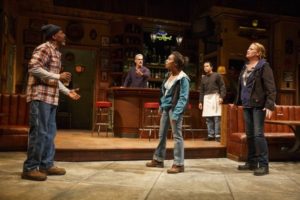 Edward R. Murrow interviews Noël Coward on Person to Person. This episode was originally telecast by CBS on April 27, 1956:
Edward R. Murrow interviews Noël Coward on Person to Person. This episode was originally telecast by CBS on April 27, 1956:
(This is the latest in a series of arts-related videos that appear in this space each Monday, Wednesday, and Friday)
Terry Teachout on the arts in New York City
In today’s Wall Street Journal I review the Irish Repertory Theatre’s production of a newly revised version of Finian’s Rainbow. Here’s an excerpt.
* * *
“Finian’s Rainbow” is one of Broadway’s most recalcitrant “problem” musicals. The original 1947 production ran for 725 performances and spawned two blue-chip standards, “How Are Things in Glocca Morra?” and “Old Devil Moon.” But none of the show’s three subsequent Broadway revivals, the most recent of which was a flawlessly cast 2009 production that closed after just three months, was commercially successful, and the 1968 film version, directed by Francis Ford Coppola and starring none other than Fred Astaire, was a box-office disaster that succeeded only in killing off the old-fashioned studio musical as a genre. Given this dismal track record, it’s quite something to report that the Irish Repertory Theatre has now done the seemingly impossible: Its new off-Broadway revival of “Finian’s Rainbow” is so delightful that the run of the show has already been extended.
 Why has “Finian’s Rainbow” proved so hard to revive? The answer is regrettably simple: The book, by E.Y. “Yip” Harburg and Fred Saidy, is a heavy-handed mishmash of stage-Irish whimsy-whamsy and Popular Front sermonizing (Harburg was a fellow-traveling socialist) that is as leaden as the score, by Harburg and Burton Lane, is radiantly lyrical….
Why has “Finian’s Rainbow” proved so hard to revive? The answer is regrettably simple: The book, by E.Y. “Yip” Harburg and Fred Saidy, is a heavy-handed mishmash of stage-Irish whimsy-whamsy and Popular Front sermonizing (Harburg was a fellow-traveling socialist) that is as leaden as the score, by Harburg and Burton Lane, is radiantly lyrical….
Enter Charlotte Moore, the artistic director of the Irish Rep and the director of this small-scale revival, who requested and received permission from the estates of the authors of “Finian’s Rainbow” to drastically revise the show. She’s done so with a scythe, cutting the running time to two tight hours, in large part by hacking away at the Harburg-Saidy book until all that’s left is its bare bones….
To be sure, Ms. Moore hasn’t rewritten “Finian’s Rainbow” from snout to tail. It’s still the same old silly story of Rainbow Valley, Missitucky, an Edenically biracial community of poor sharecroppers who thwart a racist senator (Dewey Caddell) by persuading a twee little leprechaun (Mark Evans) to turn him into a black man and who are themselves then corrupted (if only briefly) by unforeseen wealth that turns the “idle poor” into the “idle rich.” The characters still burble dialogue like “Me feet are not walkin’ another step till they know where they’re goin’!” Fortunately, they now spend most of their time singing instead of talking, and you won’t hear better singing—or better songs—on any New York stage.
This brings us to the best news of all, which is the presence in the cast of Melissa Errico. Ms. Errico was last mentioned in this space when a vocal-chord hemorrhage forced her out of the cast of John Doyle’s great 2013 Classic Stage Company revival of “Passion” shortly after opening night. It looked for a time as though her career might be over, but she has since recovered completely, and her performance as Sharon, an Irish lass who comes to Rainbow Valley from Glocca Morra and there finds love with one of the locals (Ryan Silverman), is the stuff dreams are made of….
* * *
Read the whole thing here.
A trailer for the Irish Rep revival of Finian’s Rainbow:
I posted this for the first time on November 11, 2008. It’s still relevant, and (I suspect) always will be.
* * *
 On October 9, 1918, an HMV sound engineer named Will Gaisberg set up a primitive piece of recording equipment immediately behind a unit of the Royal Garrison Artillery stationed outside Lille and recorded a British gas-shell bombardment. His purpose in doing so was to preserve the sounds of war before the coming armistice caused them to vanish forever from the face of the earth.
On October 9, 1918, an HMV sound engineer named Will Gaisberg set up a primitive piece of recording equipment immediately behind a unit of the Royal Garrison Artillery stationed outside Lille and recorded a British gas-shell bombardment. His purpose in doing so was to preserve the sounds of war before the coming armistice caused them to vanish forever from the face of the earth.
According to HMV’s catalogue, the recording, which was commercially released, consisted of
the actual reproduction of the screaming and whistling of the shells previous to the entry of the British troops into Lille. It is not an imitation but was recorded on the battlefront. The report of the guns and the whistling of the shells is the actual sound of the Royal Garrison Artillery in action on October 9th, 1918. No book or picture can ever visualise the reality of modern warfare just the way this record has done…it would require only the slightest imagination for one, by means of this record, to be projected into the past, and feel that he is really present on the battlefield witnessing this historic chapter of the war.
Here is Gaisberg’s own account of the making of the recording:
Gradually we came within the sound of the guns, and eventually, when only a short distance from Lille, we pulled up at a row of ruined cottages, in one of which the heavy siege battery had made its quarters. In the wrecked kitchen we unpacked our recording machines and made our preparations before getting directly behind a battery of great 4.5′ guns and 6′ howitzers, camouflaged until they looked at close quarters like giant insects. Here the machine could well catch the finer sounds of the “singing,” the “whine,” and the “scream” of the shells, as well as the terrific reports when they left the guns.
Dusk fell, and we were obliged, very reluctantly, to pack up our recording instrument and return to Boulogne–and to England; but we brought with us a true representation of the bombardment, which will have a unique place in the history of the Great War.
 This recording is one of the most haunting and disturbing documents of the past that I know–one made all the more haunting by the knowledge that Gaisberg accidentally inhaled some of the gas from the attack, which damaged his lungs irreparably. In London he fell victim to the international flu epidemic that was then ravaging the city, and died on November 5, six days before World War I came to an end.
This recording is one of the most haunting and disturbing documents of the past that I know–one made all the more haunting by the knowledge that Gaisberg accidentally inhaled some of the gas from the attack, which damaged his lungs irreparably. In London he fell victim to the international flu epidemic that was then ravaging the city, and died on November 5, six days before World War I came to an end.
Today no one who served in what Woodrow Wilson called “the War to End War” is still alive. Frank Buckles, the last American veteran of World War I, died in 2011, at the age of 110. If you think of him and his comrades today–and you should–take a moment to think about Will Gaisberg as well.
* * *
HMV D378, “Actual Recording of the Gas Shell Bombardment, by the Royal Garrison Artillery (9th October, 1918), preparatory to the British Troops entering Lille”:
Here’s my list of recommended Broadway, off-Broadway, and out-of-town shows, updated weekly. In all cases, I gave these shows favorable reviews (if sometimes qualifiedly so) in The Wall Street Journal when they opened. For more information, click on the title.
BROADWAY:
• An American in Paris (musical, G, too complex for small children, closes Jan. 1, reviewed here)
• The Color Purple (musical, PG-13, some performances sold out last week, reviewed here)
• The Encounter (one-man immersive drama, PG-13, many performances sold out last week, closes Jan. 8, reviewed here)
• Hamilton (musical, PG-13, Broadway transfer of off-Broadway production, all performances sold out last week, reviewed here)
• Matilda (musical, G, closes Jan. 1, reviewed here)
• On Your Feet! (jukebox musical, G, reviewed here)
OFF BROADWAY:
• The Fantasticks (musical, G, suitable for children capable of enjoying a love story, reviewed here)
• Love, Love, Love (serious comedy, PG-13, closes Dec. 18, reviewed here)
 • Sweat (drama, PG-13, extended through Dec. 18, reviewed here)
• Sweat (drama, PG-13, extended through Dec. 18, reviewed here)
CLOSING SOON OFF BROADWAY:
• Plenty (drama, PG-13, closes Dec. 1, reviewed here)
• The Roads to Home (drama, G/PG-13, not suitable for children, closes Nov. 27, reviewed here)
An ArtsJournal Blog